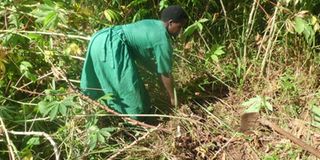Outbreak of cassava virus hits 11,000 Yumbe farmers

A farmer uproots diseased cassava from her garden. Photo | Lominda Afedraru | File
What you need to know:
- Ms Mariam Akiror, the programme manager at Action Against Hunger, a local non-governmental organisation, said this posed a challenge for food security in the district. She said there is a need for humanitarian intervention to affected farmers.
About 11,000 farmers in Yumbe District are grappling with the burden of cassava brown streak disease and cassava mosaic disease that is ravaging the gardens.
On Tuesday, Mr Rashid Ochile, a resident of Onoko Parish in Odravu Sub-county, and one of the affected farmers, said: “My cassava has been destroyed at a young stage. I do not expect much yield.”
He said farmers have sought advisory services but in vain because they have limited knowledge on how to curb the disease.
Another farmer at Olukenga Parish, Mr Waigasto Waiga, said the disease has been in the district but this time round persistent, it is spreading to other sub-counties.
“On harvest, all you find are rotten cassava tubers. We are likely going to experience hunger,” he said.
Cassava is a staple food that is consumed by many families across West Nile. Families use it for both subsistence and commercial purposes.
Mr Ali Galu, the Kululu Sub-county agriculture officer, said it is a variant of cassava disease affecting large parts of Yumbe District, particularly in the sub-counties of Odravu and Kululu.
“The Cassava Brown Streak Disease (CBSD) and Cassava Mosaic are devastating diseases that cause loss of cassava root production and quality in the area. These diseases can render susceptible varieties unusable if cassava roots are left in the ground. We are trying to carry out massive awareness among the farmers,” Mr Galu said.
The district production officer, Mr Rashid Kawawa, said: “We have several cassava varieties promoted in the district, including Nase 14 and 19 and now Narocas 1. We have found the disease is widespread and we are now establishing its extent.”
He added: “When you go to the market, you would realise the cost of cassava is higher, between Shs1,800 and Shs2,000 per kilogramme. This tells you the demand is high in our area and the farmers should be saved from such losses.”
Ms Mariam Akiror, the programme manager at Action Against Hunger, a local non-governmental organisation, said this posed a challenge for food security in the district. She said there is a need for humanitarian intervention to affected farmers.
“As we advocate for improved nutrition in Yumbe, pests and diseases still remain major challenges to fighting hunger and striving to improve income. Farmers need practical lessons on how to control the spread of pests and diseases,” Ms Akiror said.
According to the National Crops Resources Research Institute (NaCRRI), the disease appears as dark brown streaks and spots on stems, with dead spots on leaf scars. These streaks are most prominent on upper, green portions of the stem. Streaks may appear as scratch-like wounds on stems.
The diseased plants may show shoot tip death, which may progress into cassava stem die-back.




